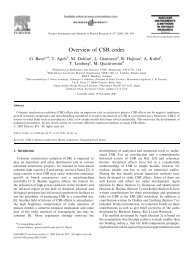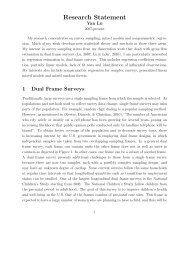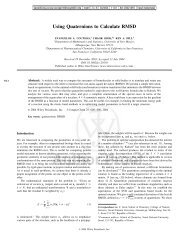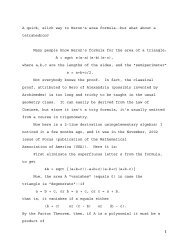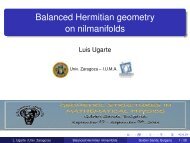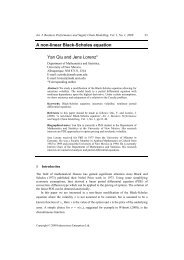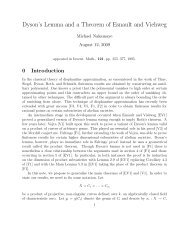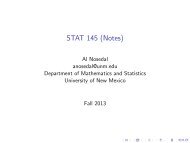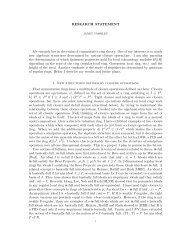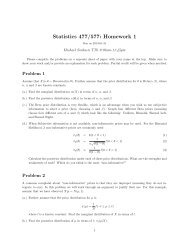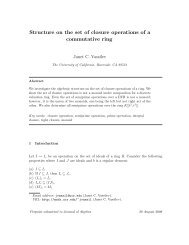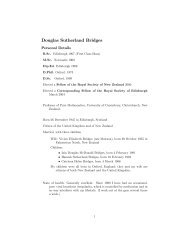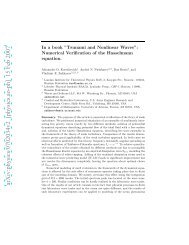OEO Office of Equal Opportunity - Department of Mathematics and ...
OEO Office of Equal Opportunity - Department of Mathematics and ...
OEO Office of Equal Opportunity - Department of Mathematics and ...
You also want an ePaper? Increase the reach of your titles
YUMPU automatically turns print PDFs into web optimized ePapers that Google loves.
178 ARTS AND SCIENCES<br />
Environmental Science (ENVS)<br />
101. The Blue Planet. (3)<br />
To underst<strong>and</strong> global change <strong>and</strong> environmental concerns,<br />
this course weaves together an underst<strong>and</strong>ing <strong>of</strong> Earth’s<br />
lithosphere, atmosphere <strong>and</strong> oceans <strong>and</strong> how ecosystems<br />
are linked to the physical environment. Students are encouraged,<br />
but not required, to enroll concurrently in 102L.<br />
102L. The Blue Planet Laboratory. (1)<br />
Introductory environmental earth science laboratory. Includes<br />
minerals, rocks, <strong>and</strong> rock cycle, topographic maps, local geology<br />
<strong>and</strong> groundwater, weather <strong>and</strong> climate.<br />
Pre- or corequisite: 101.<br />
330. Environmental Systems. (3)<br />
Study <strong>of</strong> the human relationship to <strong>and</strong> impact on the physical<br />
environment. Sustainable development <strong>and</strong> management <strong>of</strong><br />
resources. Global change <strong>and</strong> implications for ecosystems.<br />
Environmental law, policy, regulations <strong>and</strong> ethics.<br />
Prerequisites: (101 or EPS 101) <strong>and</strong> CHEM 121L <strong>and</strong> (MATH<br />
162 or BIOL 123/124L or PHYC 160). {Fall}<br />
430./530. Advanced Environmental Science. (3)<br />
Application <strong>of</strong> basic science to the interdisciplinary study <strong>of</strong><br />
environmental systems. Causes <strong>of</strong> <strong>and</strong> solutions to l<strong>and</strong>, air,<br />
water <strong>and</strong> ecosystem degradation.<br />
Prerequisites: 330 <strong>and</strong> MATH 163 <strong>and</strong> PHYC 160 <strong>and</strong> CHEM<br />
121L <strong>and</strong> BIOL 123/124L. {Spring}<br />
530/430. Advanced Environmental Science. (3)<br />
Application <strong>of</strong> basic science to the interdisciplinary study <strong>of</strong><br />
environmental systems. Causes <strong>of</strong> <strong>and</strong> solutions to l<strong>and</strong>, air,<br />
water <strong>and</strong> ecosystem degradation.<br />
Natural Science (NTSC)<br />
No major or minor <strong>of</strong>fered.<br />
Matthew W. Nyman, Coordinator<br />
Natural Sciences<br />
Northrop Hall 126<br />
MSC03 2040<br />
1 University <strong>of</strong> New Mexico<br />
Albuquerque, NM 87131-0001<br />
(505) 277-4355<br />
261L. Physical Science. (4)<br />
For pre-service K-8 teachers only. A broad, interdisciplinary<br />
introduction to the science <strong>of</strong> geology, chemistry, physics<br />
<strong>and</strong> astronomy, with emphasis on the sciences processes,<br />
inquiry <strong>and</strong> the integration <strong>of</strong> technology. The course is activity-based,<br />
utilizing a problems-<strong>and</strong>-issues based approach;<br />
various teaching methods are modeled <strong>and</strong> practiced by<br />
students; some field trips may be required.<br />
262L. Life Science. (4)<br />
For pre-service K-8 teachers only. An activity-based study <strong>of</strong><br />
science topics including botany, cell biology, genetics, microbiology<br />
<strong>and</strong> zoology with emphasis on science processes,<br />
inquiry <strong>and</strong> the integration <strong>of</strong> technology. Various teaching<br />
methods are modeled <strong>and</strong> practiced by students; some field<br />
trips may be required.<br />
Prerequisite: 261L, MATH 112.<br />
263L. Environmental Science. (4)<br />
For pre-service K-8 teachers only. An activity-based interdisciplinary<br />
study <strong>of</strong> major issues in environmental science<br />
with emphasis on science process, scientific investigations<br />
<strong>and</strong> field-based activities <strong>and</strong> the integration <strong>of</strong> technology.<br />
Course topics include current issues on population, healthy<br />
ecosystems <strong>and</strong> natural resources. Various teaching methods<br />
are modeled <strong>and</strong> practiced by students.<br />
Prerequisites: 261L, 262L.<br />
400*. Science Topics for Educators. (1-4 to a maximum<br />
<strong>of</strong> 6).<br />
Topics in specific science content areas with a focus on scientific<br />
process <strong>and</strong> inquiry. Topics vary; lectures are normally<br />
supplemented with laboratory exercises.<br />
Restriction: permission <strong>of</strong> instructor.<br />
ECONOMICS<br />
Philip T. G<strong>and</strong>erton, Chairperson<br />
The University Of New Mexico<br />
<strong>Department</strong> <strong>of</strong> Economics<br />
MSC05 3060<br />
1 University <strong>of</strong> New Mexico<br />
Albuquerque, NM 87131-0001<br />
(505) 277-5304; FAX (505) 277-9445<br />
Pr<strong>of</strong>essors<br />
Robert Berrens, Ph.D., Oregon State University<br />
Alok K. Bohara, Ph.D., University <strong>of</strong> Colorado<br />
David S. Brookshire, Ph.D., The University <strong>of</strong> New Mexico<br />
H. Stuart Burness, Ph.D., University <strong>of</strong> Kansas<br />
Donald Coes, Ph.D., Princeton University<br />
Philip G<strong>and</strong>erton, Ph.D., University <strong>of</strong> California<br />
(Santa Barbara)<br />
Christine Sauer, Ph.D., Brown University<br />
Associate Pr<strong>of</strong>essors<br />
Melissa Binder, Ph.D., Columbia University<br />
Janie Chermak, Ph.D., Colorado School <strong>of</strong> Mines<br />
Kate Krause, Ph.D., University <strong>of</strong> Wisconsin<br />
Richard Santos, Ph.D., Michigan State University<br />
Assistant Pr<strong>of</strong>essors<br />
Matias Fontenla, Ph.D., University <strong>of</strong> Texas at Austin<br />
Kristine Grimsrud, Ph.D., Washington State University<br />
Jennifer Thacher, Ph.D., University <strong>of</strong> Colorado, Boulder<br />
Affiliated Faculty<br />
Lawrence Waldman, Ph.D., The University <strong>of</strong> New Mexico<br />
(Economist III, BBER, UNM)<br />
Pr<strong>of</strong>essors Emeriti<br />
Shaul Ben-David, Ph.D., Cornell University<br />
F. Lee Brown, Ph.D., Purdue University<br />
Albert Church, Ph.D., Claremont Graduate School<br />
Ronald Cummings, Ph.D., University <strong>of</strong> Kansas<br />
Micha Gisser, Ph.D., University <strong>of</strong> Chicago<br />
Peter Gregory, Ph.D., Harvard University<br />
David Hamilton, Ph.D., University <strong>of</strong> Texas<br />
Chung Pham, Ph.D., University <strong>of</strong> Pennsylvania<br />
Donald Tailby, Ph.D., Rutgers University<br />
Paul Therkildsen, Ph.D., University <strong>of</strong> Colorado<br />
Nathaniel Wollman, Ph.D., Princeton University<br />
Introduction<br />
Why is there pollution? Why are the rainforests vanishing? Is<br />
the federal budget deficit a problem? Will graduating seniors<br />
ever collect on Social Security? Will consumers benefit from<br />
increased competition in the electricity market? Why <strong>and</strong> how<br />
would people shop on the Internet? Can government policies<br />
reduce unemployment? Is crime an economic problem? Why<br />
are some countries rich <strong>and</strong> others poor? Does international<br />
trade help or hurt workers in the United States?<br />
Economics provides answers to questions like these by analyzing<br />
how scarce resources are used <strong>and</strong> how goods <strong>and</strong><br />
services are distributed. Students <strong>of</strong> economics learn how<br />
incentives shape human behavior <strong>and</strong> why people debate<br />
public policies. Majors develop analytical <strong>and</strong> quantitative<br />
skills, including modeling, econometrics <strong>and</strong> forecasting.<br />
They underst<strong>and</strong> macroeconomic relationships that explain<br />
economic growth, unemployment <strong>and</strong> inflation <strong>and</strong> exchange<br />
rate fluctuations. They also study the microeconomics <strong>of</strong><br />
government policies, work, industrial organization, labor <strong>and</strong><br />
UNM CATALOG 2006–2007 Symbols, page 611.



